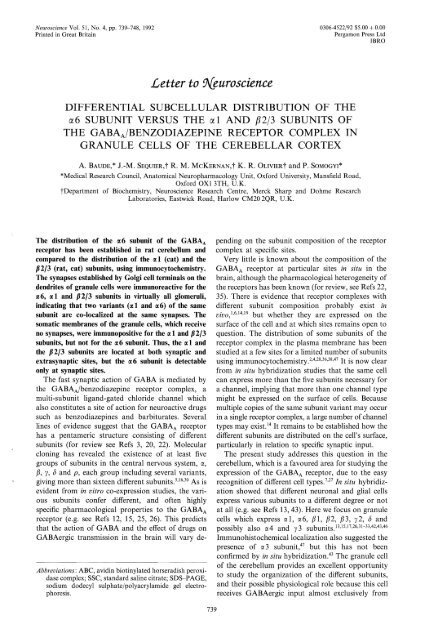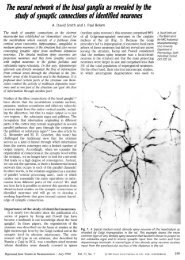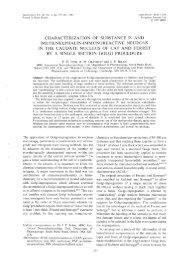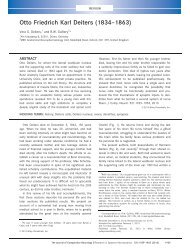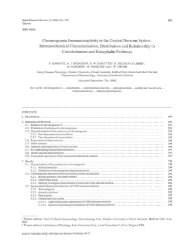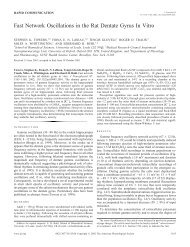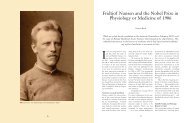Letter to :J&-uroscience - Anatomical Neuropharmacology Unit
Letter to :J&-uroscience - Anatomical Neuropharmacology Unit
Letter to :J&-uroscience - Anatomical Neuropharmacology Unit
- No tags were found...
You also want an ePaper? Increase the reach of your titles
YUMPU automatically turns print PDFs into web optimized ePapers that Google loves.
Subcellular localization of GABA A recep<strong>to</strong>r subunits 741Fig. 1procedure, and was more sensitive <strong>to</strong> particular conditionsthan immunoreactivity for the other subunits.Increasing concentration of glutaraldehyde (over0.05%), longer duration of fixation (over 10 min) orhigher temperature (best results were obtained withice-cold fixative) reduced the immunoreactivity probablyby altering the epi<strong>to</strong>pe(s). The antiserum specificfor the a6 subunit was applied <strong>to</strong> sections of ratand cat brain, but immunoreactivity could only beobserved in rat tissue. The lack of immunoreactivityin the cat may indicate that the antiserum doesnot cross-react with cat protein, although the serumwas raised <strong>to</strong> a large polypeptide containing severalpossible epi<strong>to</strong>pes. However, there is no evidence yetthat the a6 subunit is expressed in cat cerebellum.Antibody bd-17 specific for the f32/3 subunits gavesimilar results in both species; antibody bd-24 specificfor the a I subunit reacted only with cat tissue. Ithas been shown that both antibodies bd-17 andbd-24 react with human, monkey, bovine and catprotein, but only antibody bd-17 recognizes the ratprotein. ll • 28 ,38 Antibody bd-24 lacks reactivity withthe rat polypeptide due <strong>to</strong> the absence of a leucineat position 4 as compared <strong>to</strong> the bovine polypeptide.8Immunoreactivity for the a6 subunit was restricted<strong>to</strong> the granule cell layer of the cerebellar cortex(Fig. IB) in the rat brain, in agreement with the in situhybridization results. No systematic differences wereseen between the different folia in the intensity of the
Subcellular localization of GABA" recep<strong>to</strong>r subunits 743# rat-(32/3 "t ~; rat-a6rnlrnlrnlFig. 2also immunoreactive and immunoreactivity was presentat the extracellular face of the granule cellplasma membrane, demonstrating extracellular epi<strong>to</strong>pes.The reaction was present all around the granulecell dendrites including the synaptic cleft of theGolgi cell terminals. The granule cell somatic membranewas also immunopositive for both the rx 1 andf32/3 subunits. As previously described, peroxidaseend-product was present between the membranesof neighbouring granule cell bodies, although theyreceived no synapses. J8 This was in contrast <strong>to</strong> peroxidasereaction end-product observed after using antiserum<strong>to</strong> the rx6 subunit. In the latter case only rarelywere small patches of peroxidase reaction productdetected in the somata of granule cells. This labellingwas present in all layers and in all cells and was aresult of background staining in the avidin biotinylatedhorseradish peroxidase complex (ABC) procedure.Immunoreactivity could not be observed inany axon terminal, Golgi or glial cells for any of thesubunits studied here.Distribution of immunoreactivity for the rx 6 sub unit incomparison with in situ hybridization and recep<strong>to</strong>rbindingUsing an antiserum specific for the rx6 subunit ofthe GABA A recep<strong>to</strong>r, the subunit is found restricted<strong>to</strong> the dendrites of the granule cells. This correlateswell with the expression of the mRNA coding for therx6 subunit in the granule cellsY·15 The selectivelocalization of immunoreactivity <strong>to</strong> granule cells ofthe cerebellum also confirms the specificity of the
744 A. BAuDE et al.antiserum suggested by immunochemical characterization.Furthermore, the localization of immunoreactionend-product <strong>to</strong> the intracellular face of theplasma membrane confirms the <strong>to</strong>pographical organizationof the subunit in the lipid bilayer as predictedfrom the amino acid sequence. 15.30The granule cell layer is labelled strongly with[3Hjmuscimol,24 showing high-affinity GABA bindingsites, but few benzodiazepine agonist binding siteshave been found (for review, see Ref. 21). However,the partial inverse agonist [3HjRo 15-4513. in thepresence of diazepam, shows binding restricted <strong>to</strong> thegranular layer of the cerebellar cortex. 34 This apparentparadox has been explained by results from theco-expression of the 1X6, f32 and y2 sub units incultured cells. This subunit composition produced aGABA A recep<strong>to</strong>r which binds with high affinity muscimol,as well as RoI5-4513 and the structurallyrelated antagonist RoI5-l788, but not other benzodiazepineagonists or f3-carbolinesY Taken <strong>to</strong>getherwith the restricted localization of the 1X6 subunit, thissuggests that the IX 6 subunit is part of the high-affinityGABA binding site on granule cells.Different subcellular distribution for the 1X6 versus IX Iand f32/3 subunits of the GABA A recep<strong>to</strong>rFrom the distribution of the peroxidase endproductit is concluded that the IX 6 subunit is mainlylocated at synapses, although the presence of loweramounts at non-synaptic recep<strong>to</strong>r in the dendriticmembrane cannot be excluded with the present technique.In any case, the 1X6 subunit was not detectedin the somatic membrane under our conditions,showing the first cvidence of a differential subcellulardistribution of subunits of thc GABA Arecep<strong>to</strong>r.In contrast, the IXI and /32/3 subunits are presentboth at synaptic and extrasynaptic sites. 38 The lattertwo subunits have been found at synaptic and nonsynapticsites in the thalamus and cortex as well,l6,37indicating that the granule cclls are not unique in thisrespect. The possibility that the apparent widespreadlocalization of the IX I and /32/3 subunits is due <strong>to</strong>technical fac<strong>to</strong>rs connected <strong>to</strong> the extracellular epi<strong>to</strong>pes,e.g, the spread of the peroxidase end-productin the extracellular space from synaptic <strong>to</strong> extrasynapticsites, has been discussed earlier, and is veryunlikely.3H The granule cell was chosen for this studybecause it does not receive synapses on its somaticmembrane which is in direct membrane appositioneither <strong>to</strong> astrocytes or <strong>to</strong> other granule cells. Since allthe synapses are concentrated in the glomeruli wellseparated from the somata it is not easy <strong>to</strong> envisagediffusion of reaction product <strong>to</strong> the somatic membrane<strong>to</strong> sites where granule cell bodies are contactingeach other over tens of square micrometres. Thepresence of extrasynaptic recep<strong>to</strong>r/channcl complexeswhich are able <strong>to</strong> bind GABA and pass chloride ions,is also confirmed by whole-cell patch-clamp recordingsfrom cerebellar slices, which show chloride currentswith fast rise-time in response <strong>to</strong> brief (5-10 ms)ionophoretic pulses of GABA applied <strong>to</strong> the soma(Farrant M. and Cull-Cundy S. G., personal communication).It remains <strong>to</strong> be seen whether the channelbehaviour is in line with the predicted subunitcomposition.Composition of GABA A recep<strong>to</strong>r complex in granulecellsLigand binding studies in the cerebellum showedhigh-affinity GABA recep<strong>to</strong>rs in the granule celllayer, but few benzodiazepine agonist bindingsites. 21 ,24,44 However, the expression of the IX I subunitI7 ,31,33 (which is thought <strong>to</strong> be responsible for typeI benzodiazepine recep<strong>to</strong>r pharmacology25) and itslocalization in the granule cell plasma membrane,38suggest the presence of at least some sites for benzodiazepines.Immunoprecipitation experiments indicatethat a native recep<strong>to</strong>r in the cerebellum includesthe 1X6 subunit,15 but the {;(6 subunit probably occursin a separate channel complex from the one containingthe IX 1 subunit (Quirk K., Gillard N., Ragan C. I.,Whiting P., McKernan R. M., unpublished observations).Granule cells also abundantly express theband y2 subunits. Immunoreactivity for the (j subunitseems <strong>to</strong> be concentrated in the glomerulj,2suggesting colocalization with the 1X6 sub unit. Immunoprecipitationresults indeed revcal that both :'(6and b subunits exist in a recep<strong>to</strong>r complex which---- - -------Fig. 3. Electron micrographs showing immunoreactivity for the 0(6 subunit in granule cells of the cerebellarcortex in rat. Immunoreactivity is only present in the dendrites (asterisks in A) of the granule cells (gc).The immunoperoxidase end-product is most dense at the synaptic junctions (thin arrows in B) formedwith Golgi cell terminals (Gt). The weaker diffuse reaction end-product in the dendrites is interpreted asoriginating mainly from synaptic plasma membranes. One of the dendrites (asterisk in B) receives animmunoposilive synapse from a Golgi terminal (thin arrow) and an immunonegative synapsc from amossy fibre terminal (m!). Immunoreactivity for the rx6 subunit is absent from a granule cell soma (gc)and a glial cell (Gl). Scale bars = 0.5 I,m (A); O.21'm (B). Immunocy<strong>to</strong>chemistry was performed asdescribed in Fig. 2 with the difference that no Tri<strong>to</strong>n X-lOO was used. After 3,3'-diaminobenzidincreaction, the sections were treated with 1 % OS04 in 0.1 M phosphate buffer for 1 h, washed in distilledwater and placed for 1 h in uranyl acetate (1 % in distilled water). After dehydration in graded ethanoland propylene oxide, the sections were infiltrated with epoxy resin (DURCUPAN ACM, Fluka) overnightand flat-embedded on glass slides for light microscopic assessment. Areas of interest were re-embeddedfor electron microscopic sectioning. A <strong>to</strong>tal of 13 blocks, including all layers of the cerebellar cortex werestudied for the rx 6 subunit. The ultrathin sections were not stained. Three blocks for the f32/3 subunit andtwo blocks for the rx I subunit were also studied according <strong>to</strong> the same procedure.
Subcellular localization of GABA A receplor subunits 745Fig. 3
746 A. BAUDE et al.binds eH]muscimol, but not benzodiazepines (Quirket al., unpublished observations). Immunoprecipitationdata for othcr a subunits also suggest thatthey participate in different recep<strong>to</strong>r/channel complexes,!,6,!9 but the presence of several different variantsin a single recep<strong>to</strong>r complex has also beenreportcd.!4 Thcre is no reason why these two possibilitiesshould be mutually exclusive for all areas of thebrain. Whatever the case, our results in the cerebellumsuggest that, at least in the somatic membranc,recep<strong>to</strong>rs exist without the 0:6 subunit.Thc immunolabelling of virtually all glomeruli forall three subunits shows that granule cells are ahomogeneous population of neurons with respect <strong>to</strong>their GABA A recep<strong>to</strong>r composition, although clearlyfurther studies are needed on the other subunits thatthey are known <strong>to</strong> express (see Introduction for Refs).We show here that the 0:6 subunit is part of thesynaptic recep<strong>to</strong>r complex in the granule cell membrane.The same site, i.e. the synapse with thc Golgicell, also includes the fJ2/3 subunits in the rat.Unfortunately, since the antibody <strong>to</strong> the a 1 subunitdoes not cross react with the rat recep<strong>to</strong>r, we couldnot test its presence at the synapses of the rat.Nevertheless, granule cells in thc rat exprcss the a 1subunit abundantly)! and in homology with the cat,it is very likcly <strong>to</strong> be present at the Golgi cell synapsesof the rat as well. Consequently, GABA released atthe same synapse probably activates different recep<strong>to</strong>rsthat include either the a 1 or the a6 subunits, thelattcr unique <strong>to</strong> this synapse.Another special feature of this synapse is that theGolgi cell terminals also contain high concentrationof not only GABA, but another inhibi<strong>to</strong>ry aminoacid, glycineY Glycine is released in a Ca 21 -dependentmanner from cerebellar slices,J9 but no strychninebinding sites have been found in the granule celllayer,45 demonstrating that the glycinc released formGolgi cells does not act on strychnine-sensitive glycinerecep<strong>to</strong>rs coupled <strong>to</strong> chloride channels. However,mRNAs coding for the ex 3 and fJ subunits of theglycine recep<strong>to</strong>r complex are abundant in granulecells.!S It would be interesting <strong>to</strong> test the effect ofglycine on various combinations of GABA A recep<strong>to</strong>rsubunits known <strong>to</strong> be present in granule cells, andalso under conditions expressed <strong>to</strong>gether with theglycine recep<strong>to</strong>r a3 and fJ subunits.Most cells in the CNS receive GABA from morethan one source and the surface of neurons isspatially subdivided amongst the different inputs (e.g.see Ref. 37). The multiplicity of the GABA A recep<strong>to</strong>rmay reflect, at the molecular level, this structuraldesign and may support distinct pharmacologicalactions of GABA at separate inputs. However, mos<strong>to</strong>f the gran ule cells of the ccrebellar cortex receiveGABAergic input only from the Golgi cells, and stillthey express more than one type of recep<strong>to</strong>r complex,with differential distribution on the surface of the cell.Consequently, the response of the cell <strong>to</strong> drugs andendogenous agonists may change according <strong>to</strong> thedynamic distribution of the different channel types ofthe GABA A recep<strong>to</strong>r.Acknowledgements·-We thank Dr J. Grayson Richards forproviding the monoc1onal antibodies bd-24 and bd-17, Drs1. Ragan and L. L. Iversen for their support in the project,Miss D. Latawiec and Mr J. D. B. Roberts for excellenttechnical assistance, Mr Frank Kennedy and Mr Paul Jaysfor pho<strong>to</strong>graphic assistance. A. Baude was supported by"Bourse Lavoisier, Ministere des Affaires Etrangeres.France".REFERENCES1. Benke D., Cicin-Sain A., Mertens S. and Mohler H. (1991) Immunochemical identification of the od- and rx3-subunitsof the GABAA reccp<strong>to</strong>r in rat brain. J. Recept. Res. 11, 407-424.2. Benke D., Mertens S., Trzeciak A., Gillessen D. and Mohler H. (1991) Identification and immunohis<strong>to</strong>chemicalmapping of GAB AA recep<strong>to</strong>r subtypes containing the l'-subunit in rat brain. Fedn Eur. biochem. Soc. Lett. 283, 145-149.3. Betz H. (1990) Ligand-gated ion channels in the brain: the amino acid recep<strong>to</strong>r superfamily. Neuron 5, 383-392.4. Dc BIas A. L., Vi<strong>to</strong>rica J. and Friedrich P. (1988) Localization of the GABAA receplor in the rat brain with amono clonal antibody <strong>to</strong> the 57,000 Mr peptide of the GABAA recep<strong>to</strong>r/benzodiazepine recep<strong>to</strong>r/CI- channel complex.J. Neurosci. 8, 602--614.5. Doble A. and Martin I. L. (1992) Multiple benzodiazepine recep<strong>to</strong>rs: no reason for anxiety. Trends pharmac. Sei. 13,76-81.6. Duggan M. J. and Stephensoll F. A. (1990) Bicohemical evidence for the existence of ,·-aminobutyrateA recep<strong>to</strong>riso-oligomers. J. bioi. Chem. 265, 3831-3835.7. Eccles J. C., I<strong>to</strong> M. and Szentagothai J. (1967) The Cerebellum as a Neuronal Machine. Springer, Berlin.8. Ewert M., Shivers B. D., Luddens H., Mohler H. and Seeburg P. H. (1990) Subunit selectivity and epi<strong>to</strong>pecharacterization of mAbs directed against the GABAA/benzodiazepine recep<strong>to</strong>r. J. Cell BioI. 110, 2043-2048.9. Gallyas F., Gorcs T. and Merchenthaler 1. (1982) High grade intensification of the end product of DAB reactiondemonstrating peroxidase activity. J. His<strong>to</strong>chem. Cy<strong>to</strong>chcl11. 30, 183-184.10. Hamori J. and Takacs J. (1989) Two types of GABA-containing axon terminals in cerebellar glomeruli of cat: animmunogold study. Expl Brain Res. 74, 471-479.11. Haring P., Stahli C., Schoch P., Takacs B., Staehelin T. and Mohler H. (1985) Monoclonal antibodies reveal structuralhomogeneity of i'-aminobutyric acid/benzodiazcpine recep<strong>to</strong>rs in different brain areas. Proc. na/n. Acad. Sci. U.S.A.82, 4837-4841.12. Knofiach F., Backus K. H., Giller T., Malherbe P., Pllimlin P., Mohler H. and Trube G. (1992) Pharmacological ande1ectrophysiological properties of recombinant GABAA recep<strong>to</strong>rs comprising the at3, PI and y2 subunits. Eur. J.Neurosci. 4, 1-9.
Subcellular localization of GABAA recep<strong>to</strong>r subunits 74713. Laurie D. J., Seeburg P. H. and Wisden W. (1992) The distribution of 13 GABAA recep<strong>to</strong>r subunit mRNAs in therat brain. n. Olfac<strong>to</strong>ry bulb and cerebellum. J. Neurosci. 12, 1063-1076.14. Luddens H., Killisch I. and Seeburg P. H. (1991) More than one alpha variant may exist in a GABAA/benzodiazepinerecep<strong>to</strong>r complex. J. Recept. Res. 11, 535-551.15. Luddens H., Pritehett D. B., Kohler M., Killisch I., Keinanen K., Monyer H., Sprengel R. and Seeburg P. H. (1990)Cerebellar GABA, recep<strong>to</strong>r selective for a behavioural alcohol antagonist. Nature 346, 648-651.16. Luddens H. and Wisden W. (1991) Function and pharmacology of multi plc GABA A recep<strong>to</strong>r subunits. Trends Pharmac.Sci. 12, 49-51.17. Malherbe P., Si gel E., Baur R., Persohn E, Richards J. G. and Mohler H. (1990) Functional characteristics and sitesof gene expression of the cxl,{3I,y2-isoform of the rat GABA A recep<strong>to</strong>r. 1. Neurosci. 10,2330-2337.18. Malosio M. L., Marqueze-Pouey B., Kuhse J. and Betz H. (1991) Widespread expression of glycine recep<strong>to</strong>r subunitmRNAs in the adult and developing rat brain. Eur. mo/ec. Bioi. Org. J. 10,2401-2409.19. McKernan R. M .. Quirk K., Prince R., Cox P. A., Gillard N. P., Ragan C. I. and Whiting P. (1991) GABAA recep<strong>to</strong>rsubtypes immunopurified from rat brain with rx subunit-specific antibodies have unique pharmacological properties.Neuron 7, 667-676.20. Olsen R. W., Bureau M., Khrestchatisky M., MacLennan A. J., Chiang M. Y., Tobin A. J., Xu W., Jackson M., SterniniC. and Brecha N. (1990) Isolation of pharmacologically distinct GABA-benzodiazepine recep<strong>to</strong>rs by protein chemistryand molecular cloning. Adv. biochem. Psychopharmac. 46, 35-49.21. Olsen R. W., McCabe R. T. and Wamsley J. K. (1990) GABAA recep<strong>to</strong>r subtypes: au<strong>to</strong>radiographic comparison ofGABA, benzodiazepine, and convulsant binding sites in the rat central nervous system. J. chem. Neuroanat. 3, 59-76.22. Olsen R. W. and Tobin A. J. (1990) Molecular biology of GABAA recep<strong>to</strong>rs. Fedn Am. Socs expo Bioi. J. 4, 1469-1480.23. Ottersen O. P., S<strong>to</strong>rm-Mathisen J. and Somogyi P. (1988) Colocalization of glycine-like and GABA-like immunoreactivitiesin Golgi cell terminals in the rat cerebellum: a postembedding light and electron microscopic study. BrainRes. 450, 342-353.24. Palacios J. M., Young W. S. and Kuhar M. J. (1980) Au<strong>to</strong>radiographic localization of y aminobutyric acid (GABA)recep<strong>to</strong>rs in rat cerehellum. Proc. natn. Acad. Sci. U.S.A. 77, 670-679.25. Pritchett D. B., Luddens H. and Seeburg P. H. (1989) Type I and type II GABAA-benzodiazepine recep<strong>to</strong>rs producedin transfected cells. Science 245, 1389-1392.26. Pritchett D. B., Sontheimer H., Shivers B. D., Ymer S., Kettenmann H., Schofield P. R. and Seeburg P. H. (1989)Importance of a novel GABA A recep<strong>to</strong>r subunit for benzodiazepine pharmacology. Nature 338, 582-585.27. Ramon-y-Cajal S. (1955) His<strong>to</strong>logie du Systeme Nerveux de L'Homme et des Vertebres, Vo!. 2, pp. 1-106. Inst. Ramony Cajal, Madrid.28. Richards J. G., Schoch P., Haring P., Takacs B. and Mohler H. (1987) Resolving GABAA/benzodiazepine reccp<strong>to</strong>rs:cellular and subcellular localization in the CNS with monoclonal antibodies. J. Neurosci. 7, 1866-1886.29. Schoch P., Richards J. G., Haring P., Takacs B., Stahli C., Staehelin T., Haefely W. and Mohler H. (1985)Co-localization of GABAA recep<strong>to</strong>rs and benzodiazepine recep<strong>to</strong>rs in the brain shown by monoclonal antibodies.Nature 314, 168-171.30. Schofield P. R., Darlison M. G., Fujita N., Burt D. R., Stephenson F. A., Rodriguez H., Rhee L. M., RamachandranJ., Reale V., Glencorse T. A., Seeburg P. H. and Barnard E. A. (1987) Sequence and functional expression of theGABAA recep<strong>to</strong>r shows a ligand-gated recep<strong>to</strong>r super-family. Nature 328, 221-227.31. Sequier J. M., Richards J. G., Malherbe P., Price G. W., Mathews S. and Mohler H. (1988) Mapping of brain areascontaining RNA homologous <strong>to</strong> cDNAs encoding the rx and (3 subunits of the rat GABA A y-aminobutyrate recep<strong>to</strong>r.Proc. nafn. Acad. Set. US.A. 85, 7815-7819.32. Shivers B. D., Killisch I., Sprengel R., Sontheimer H., Kohlcr M., Schoficld P. R. and Seeburg P. H. (1989) Two novelGABA A recep<strong>to</strong>r sub units exist in distinct neuronal subpopulations. Neuron 3, 327-337.33. Siege! R. E (1988) The mRNAs encoding GABAA/benzodiazepine recep<strong>to</strong>r subunits are localized in different cellpopulations of the bovine cerebellum. Neuron 1, 579-584.34. Sieghart W., Eichinger A .. Richards J. G. and Mohler H. (1987) Pho<strong>to</strong>affinity labeling of benzodiazepine recep<strong>to</strong>rproteins with the partial inverse agonist FHJRo 15-4513: a biochemical and au<strong>to</strong>radiographic study. J. Neurochem. 48,46-52.35. Sivilotti L. and Nistri A. (1991) GABA recep<strong>to</strong>r mechanisms in the central nervous system. Prog. Neurobiol. 36, 35-92.36. Soltesz 1.. Roberts .T. D. B., Takagi H., Richards J. G., Mohler H. and Somogyi P. (1990) Synaptic and nonsynapticlocalization ofbenzodiazepine/GABAA reccp<strong>to</strong>r/Cl- channel complex using monoclonal antibodies in the dorsal lateralgeniculate nucleus of the cat. Eur. J. Neurosci. 2, 414·~429.37. Somogyi P. (1989) Synaptic organisation of GABAergic neurons and GABAA recep<strong>to</strong>rs in the lateral geniculate nucleusand visual cortex. In Neural Mechanisms of Visual Perception. Proceedings of the Retina Research Foundation Symposia(eds Lam D. K.-T. and Gilbert C. D.), pp. 35-62. Portfolio, The Woodlands, Texas.38. Somogyi P., Takagi H., Richards J. G. and Mohler H. (1989) Subcellular localization of benzodiazepine/GABAArecep<strong>to</strong>rs in the cerebellum of rat, cat, and monkey using monoclonal antibodies. J. Neurosci. 9, 2197-2209.39. Toggenburger G., Wiklund L., Henke H. and Cuenod M. (1983) Release of endogenous and accumulated amino acidsfrom slices of normal and climbing fiber-deprived rat cerebellar slices. J. Neurochem. 41, 1606-1613.40. van den Pol A. N. and Gores T. (1988) Glycine and glycine recep<strong>to</strong>r immunoreactivity in brain and spinal cord.J. Neurosci. 8, 472 492.41. Vi<strong>to</strong>rica J., Park D., Chin G. and de Bias A. L. (1988) Monoclonal antibodies and conventional antisera <strong>to</strong> the GAB AArecep<strong>to</strong>r/benzodiazepine recep<strong>to</strong>r/Cl- channel complex. J. Neurosci. 8, 615-622.42. Wilson-Shaw D., Robinson M., Gambarana c., Siegel R. E. and Sikcla J. M. (1991) A novel y subunit of the GABA Arecep<strong>to</strong>r identified using the polymerase chain reaction. Fedn Eur. biociJem. Socs Lett. 284,211-215.43. Wisden W., Laurie D. J., Monyer H. and Seeburg P. H. (1992) The distribution of 13 GABAA recep<strong>to</strong>r subunit mRNAsin the rat brain. I. Telencephalon, diencephalon, mesencephalon. 1. Neurosci. 12, 1040-1062.44. Young W. S., NiehoffD. L., Kuhar M. J., Beer B. and Lippa A. S. (1981) Multiple bcnzodiazepine recep<strong>to</strong>r localizationby light microscopic radio his<strong>to</strong>chemistry. J. pharmac. expo Thel'. 216, 425-436.45. Zarbin M. A., Wamsley J. K. and Kuhar M. J. (1981) Glycine recep<strong>to</strong>r: light microscopic au<strong>to</strong> radiographic localizationwith [3HJstrychnine. J. Neurosci. 1, 532-547.
748 A. BAUDE et al.46. Zhang l. H., Sa<strong>to</strong> M. and Tohyama M. (1991) Region-specific expression of the mRNAs encoding {3 subunits ({31, {32,and {13) of GABA A recep<strong>to</strong>r in the rat brain. 1. comp. Neurol. 303, 637-657.47. Zimprich F., Zezula l., Sieghart W. and Lassmann H. (1991) Immunohis<strong>to</strong>chemical localization of the aI, a2 and a3subunit of the GABA A recep<strong>to</strong>r in the rat brain. Neurosci. Lett. 127, 125-128.(Accepted 21 September 1992)


